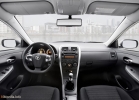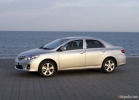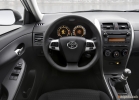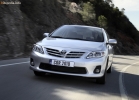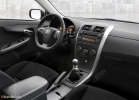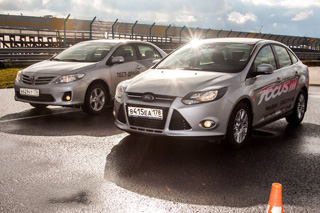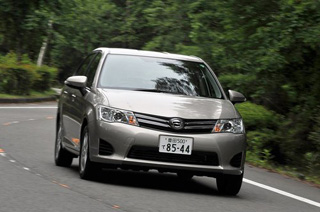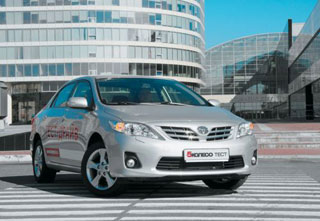Toyota Corolla test drive since 2010 hatchback
We test the new Toyota Corolla
 Toyota Corolla sales of the 2007 model year will begin in the next few weeks, but official dealers have already concluded preliminary agreements with buyers with the delivery time of April of this year. Cars arriving in Russia in February and March are already sold out. And this is despite the fact that today the cars have not yet been represented in the demonstration halls of dealers, and buyers make a decision only on the basis of a few official photographs. However, several cars are already in Moscow. One of the first who managed not only to see the new Corolla, but also to test it on the road, were the specialists of Toyota Club Russia, who kindly agreed to tell us about their impressions.
Toyota Corolla sales of the 2007 model year will begin in the next few weeks, but official dealers have already concluded preliminary agreements with buyers with the delivery time of April of this year. Cars arriving in Russia in February and March are already sold out. And this is despite the fact that today the cars have not yet been represented in the demonstration halls of dealers, and buyers make a decision only on the basis of a few official photographs. However, several cars are already in Moscow. One of the first who managed not only to see the new Corolla, but also to test it on the road, were the specialists of Toyota Club Russia, who kindly agreed to tell us about their impressions. We have been waiting for a meeting with the new Corolla for a long time. An increased interest in the new model was due not only to banal curiosity, but also by a colossal number of rumors that have recently appeared around the car. The most questions were raised by robotic mechanics, also known as a multi-modal transmission (MMT). It was such a Toyota Motor Corporation gearbox that decided to replace the 4-speed machine used on the previous generation Corolla.
In the past few years, robotic checkpoints are everywhere installed by various manufacturers on new cars of cars, however, reviews about the operational characteristics of these boxes are very contradictory. In fact, the multi-modal transmission is nothing more than a regular mechanical gearbox, gear shift and clutch, which are not carried out by the driver, but with three electric motorchers. Compared to ordinary mechanics, this design is more convenient for the driver, but, nevertheless, loses to traditional automatic transmission in the speed of gear. It was the delays in switching until recently that were one of the most important disadvantages of the multi-modal transmission, in particular, strongly poisoning the life of the last generation of Honda Civic.
 Due to the fact that the new Toyota Corolla will be delivered to the Russian market only with a mechanical and robotic transmission, going to the test drive of a new machine, we set us two main tasks. Firstly, it was extremely interesting to compare the new model with the previous generation of Corolla, and secondly, we had to evaluate the work of a robotic checkpoint with special addiction.
Due to the fact that the new Toyota Corolla will be delivered to the Russian market only with a mechanical and robotic transmission, going to the test drive of a new machine, we set us two main tasks. Firstly, it was extremely interesting to compare the new model with the previous generation of Corolla, and secondly, we had to evaluate the work of a robotic checkpoint with special addiction. Little Camry
Actually, the car with MMT appeared before us at the auto -district auto policy. We got a car in a not -poor configuration with index 32, which will be offered by official dealers for $ 22,700. The equipment of the machine to some extent resembles the configuration of the previous generation, however, it has a number of serious differences.
Even in the budget version itself, the car is equipped with front and rear disk brakes with ABS and EBD systems, four safety pillows, immobilizer, central remote control, air conditioning and side mirrors with heating and electric drives, electric front fiberglasses, and a four-retaver with four speakers. At the simplest trim levels, the steering wheel is made of polyurethane, and on cars with robotic mechanics of the steering wheel is also equipped with MMT gearboxes. The price of cars with such equipment ranges from $ 18,600 for a car with a 1.4 engine (97 hp) and a mechanical gearbox, up to $ 21,000 per car with a 1.6 engine (124 hp) and a multi-modal transmission. In the configuration that we got for a test drive, the rear electric windows, additional airbags (side curtains and a knee for the driver), automatic climate control, additional two speakers of the radio, a leather steering wheel equipped with audio control keys were added to all of the above. system and front fog lights.
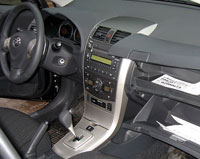
Cars with a 1.4 liter engine are delivered to the Russian market with wheels and tires 195/65/R15, while cars with a 1.6 liter engine are equipped with 205/55/R16. Castle wheels are available only on Corolla in the maximum configuration with index 60, the price of which is already $ 24,600. In addition to the wheel discs, this equipment differs from the light sensor, the rain sensor, the rear-view mirror, cruise control, and access systems for access Smart Entry & Push Start.
 Unlike the previous generation of Corolla, the new car found two pleasant additions to the equipment, which were so significantly lacking in the 2003 model of the model year. The CD resort, to the joy of fans of the brand, now knows how to lose not only the usual Audio-CD, but also to reproduce the folk MP3 format. And on the front bumper, even on cars in the minimum version, there are now there are washer washer.
Unlike the previous generation of Corolla, the new car found two pleasant additions to the equipment, which were so significantly lacking in the 2003 model of the model year. The CD resort, to the joy of fans of the brand, now knows how to lose not only the usual Audio-CD, but also to reproduce the folk MP3 format. And on the front bumper, even on cars in the minimum version, there are now there are washer washer. The appearance of Toyota Corolla 2007 has already caused a lot of disputes. The design of the machine may be liked, it may not like it, but it will not leave anyone indifferent. If the appearance of the previous generation can be called frankly inexpressive, then this can not be said about the new Corolla. The little Camry is the first thought that came to our mind when we saw this car alive. The shape of the radiator grille, the predatory squint of the headlights, the two longitudinal faces of the hood, smoothly flowing into the line of the side glasses, rising in the back of the body, the new oval rear optics and the aggressive rear bumper give the appearance of the car a slightly sporty character, favorably emphasizing the individuality. So portable appearance of the previous Corolla and sagging from the Moscow mud, plastic linings on the lower part of the thresholds disappeared. In general, we had the feeling that the designers of Toyota finally achieved what the owners of the previous generation Corolla had so lacked - the car gained individuality.
What's new in the salon
The salon turned out to be no less attractive. Due to the change in the angle of inclination of the windshield, the front panel became deeper, and slightly shifted down compared to the previous Corolla. The upper part is finished with soft gray plastic, and the central console gained a silver tint. The quality of materials and the fitting of panels is traditionally for Toyota, and we did not cause complaints. It is noteworthy that instead of a cold green shade, the backlight of the radio, the climate control unit and the devices are now emitting soft cozy amber light.
 The combination of devices is, without a doubt, one of the most remarkable improvements in the new Corolla. Unlike the previous model, the readings of the on -board computer are now displayed on a special round display, located in the center of the speedometer, which also displays the indicators of the odometer, two daily mileage meters, and even signaling the opening of the lid of the trunk. The second same round display is located in the center of the tachometer, and displays the fuel level in the tank and the temperature of the coolant in the form of vertical scales, as well as the mode of operation of the multi-modal transmission. Between the speedometer and the tachometer, the control lamps of the driver for the driver were attached, which on cars with a mechanical gearbox signal the need to turn on increased or reduced gear.
The combination of devices is, without a doubt, one of the most remarkable improvements in the new Corolla. Unlike the previous model, the readings of the on -board computer are now displayed on a special round display, located in the center of the speedometer, which also displays the indicators of the odometer, two daily mileage meters, and even signaling the opening of the lid of the trunk. The second same round display is located in the center of the tachometer, and displays the fuel level in the tank and the temperature of the coolant in the form of vertical scales, as well as the mode of operation of the multi-modal transmission. Between the speedometer and the tachometer, the control lamps of the driver for the driver were attached, which on cars with a mechanical gearbox signal the need to turn on increased or reduced gear. Doors plastic is practically identical to the materials of the previous generation Corolla, but the upholstery of the seats has become softer and pleasant to the touch. Unlike the previous generation, the cup holders in the tunnel between the seats are now covered with leaning lids. The seats themselves, although they do not have developed lateral support, are tenaciously held in the turns of the medium -complex driver, and the changed shape of the headrest now allows them to be used for their intended purpose, without risking to obtain stretching of the neck muscles. The driver's seat is adjusted horizontally and vertical, and for the driver a tall 180 cm horizontal adjustment is quite enough. The rear seats also turned out to be quite comfortable, while the legs for the legs of the rear passengers remained almost unchanged, adding, according to the manufacturer, 1 cm in length.
 The front speakers of the radio tape recorders are still in their places in the lower front of the doors. But the rear ones moved from the door to the shelf, freeing up a place for glove boxes with built -in cup holders. The rear regiment itself will now not serve as a haven for abundant clusters of dust, however, it risks becoming a source of additional creaks of the shelf lining is not made of cardboard and fabric, but of hard plastic.
The front speakers of the radio tape recorders are still in their places in the lower front of the doors. But the rear ones moved from the door to the shelf, freeing up a place for glove boxes with built -in cup holders. The rear regiment itself will now not serve as a haven for abundant clusters of dust, however, it risks becoming a source of additional creaks of the shelf lining is not made of cardboard and fabric, but of hard plastic. In general, the salon of the new Corolla, in addition to significant visual improvements, gained three improvements, which, without a doubt, will appreciate the owners of the 2003 model year. Firstly, on the new Toyota model, I finally abandoned the uncomfortable mechanism for adjusting the back of the front seats now now it is enough to raise up the lever once, and the back can be lowered and lifted as much as you like. For fixation, it is enough to return the lever to its original position. Secondly, due to the fact that the main silencer was moved closer to the motor compartment, a high tunnel disappeared, separating the floor in the legs of the rear passengers. And thirdly, the rear seat acquired a folding armrest with two built-in shallow cup holders.
 We were not too lazy to look into the trunk. There was another surprise. From now on, to the universal joy of the owners in the trunk of Toyota Corolla, loops for fastening the grid, holding the luggage. Everything else, including the material of the upholstery and a full -sized spare, remains unchanged.
We were not too lazy to look into the trunk. There was another surprise. From now on, to the universal joy of the owners in the trunk of Toyota Corolla, loops for fastening the grid, holding the luggage. Everything else, including the material of the upholstery and a full -sized spare, remains unchanged. Pluses and minuses of the box
Having familiarized himself with the inner world of the new Corolla, we began directly to the road test, which was held at the auto -district of the auto policy. As we already said above, Corolla with a 1.6 liter engine turned out to be at our disposal. with a capacity of 124 hp And that very multi-modal transmission. Of particular interest to the event was the fact that a few days before the test drive in Moscow there was abundant snowfall, and the test tracks of the landfill were covered with ice and snow, as close as possible to the conditions of the test drive to the average Russian winter realities.
 It was comfortable to accommodate at the workplace of the driver for a minute. The first thing that caught the eye of a significantly improved review. Due to the change in the angle of inclination of the windshield and reducing the thickness of the side front racks, the dead zones created by these very racks were reduced by almost 2 times. We did not measure the diameter of the steering wheel, but it seems that it decreased compared to the previous generation.
It was comfortable to accommodate at the workplace of the driver for a minute. The first thing that caught the eye of a significantly improved review. Due to the change in the angle of inclination of the windshield and reducing the thickness of the side front racks, the dead zones created by these very racks were reduced by almost 2 times. We did not measure the diameter of the steering wheel, but it seems that it decreased compared to the previous generation. The multi-modal transmission that interests us actually has 3 operating modes M, E and ES. In the MANUAL mode, the selection of the transmission is carried out by the driver by pressing the checkpoint selector: the choice of increased transmission is carried out by pressing down, the choice of lower upwards. The mode of E corresponds to the usual DRIVE in the traditional machine, when the selection of gears is carried out without the participation of the driver, but at the same time the engine speeds do not rise above 3500. In the ES mode, which is turned on the button located on the central console in front of the gearbox lever, the selection of gears is also electronically, it is electronically, However, switching occur already in the region of 6000 revolutions per minute. In all three modes, the driver has the opportunity to forcibly switch the transmission using petals located behind the steering wheel.
Having studied the driver's workplace and the principles of control of the robotic checkpoint, we fasten and start the engine. We immediately feel that it works much quieter than on the previous generation Corolla. Looking ahead, let's say that after warming up the engine, we could not feel light vibrations at idle, so characteristic of the old 1.6 engine, and caused by low quality of Russian gasoline.
 We transfer the checkpoint selector to position E, release the brake, press the gas and touch. The delay and a slight jerk that accompanied the moment of the beginning of movement on Toyota Yaris and Corolla Verso, equipped with a multi-modal transmission, are no longer good. We press the gas by about 2/3 and gain speed. It is necessary to admit 124 horsepower forces of the new 1.6 engine disperse the car a little more active than 110 horsepower of the old engine. But we, taught by the bitter experience of the functioning of the robot on Verso, are in no hurry to draw conclusions, and, without removing the leg from the gas pedal, with fading the heart we are waiting for the failure of the dynamics and pauses when switching gear from the first to the second. The moment the engine speed is falling, the machine loses the dynamics for a split second, twitches a little and starts acceleration again. A completely different thing! Here you need to explain that the same multi-modal transmission is installed on the new Toyota Corolla as on Corolla Verso, however, with altered software and several constructive modifications. As our test showed, this turned out to be quite enough. Of course, such a transmission does not yet reach the speed of gear shifts to the traditional machine. But this is no longer a mechanic, and, of course, not the robot that pulls the car during acceleration, and most importantly provides gaps of dynamics and languid seconds of expectations between gear shifts.
We transfer the checkpoint selector to position E, release the brake, press the gas and touch. The delay and a slight jerk that accompanied the moment of the beginning of movement on Toyota Yaris and Corolla Verso, equipped with a multi-modal transmission, are no longer good. We press the gas by about 2/3 and gain speed. It is necessary to admit 124 horsepower forces of the new 1.6 engine disperse the car a little more active than 110 horsepower of the old engine. But we, taught by the bitter experience of the functioning of the robot on Verso, are in no hurry to draw conclusions, and, without removing the leg from the gas pedal, with fading the heart we are waiting for the failure of the dynamics and pauses when switching gear from the first to the second. The moment the engine speed is falling, the machine loses the dynamics for a split second, twitches a little and starts acceleration again. A completely different thing! Here you need to explain that the same multi-modal transmission is installed on the new Toyota Corolla as on Corolla Verso, however, with altered software and several constructive modifications. As our test showed, this turned out to be quite enough. Of course, such a transmission does not yet reach the speed of gear shifts to the traditional machine. But this is no longer a mechanic, and, of course, not the robot that pulls the car during acceleration, and most importantly provides gaps of dynamics and languid seconds of expectations between gear shifts. 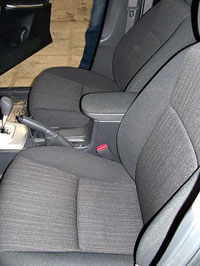 After observing the transmission process without releasing the gas pedal, we decided to try a method directly recommended for machines with MMT. We promote the engine to 3000 revolutions per minute, release the gas a little and instantly return it to its original position. And there is. The moment on which we released the gas pedal on is enough to switch the gear up. At the same time, due to the fact that we ourselves reduced the momentum, dropping the gas, a barely noticeable jerk that is present with the gas pedal pressed, is practically absent. The same thing happens when switching the transmission down. We dump the gas without releasing the pedal to the end, then we go, we again press the robot already turned on the reduced gear. Not bad.
After observing the transmission process without releasing the gas pedal, we decided to try a method directly recommended for machines with MMT. We promote the engine to 3000 revolutions per minute, release the gas a little and instantly return it to its original position. And there is. The moment on which we released the gas pedal on is enough to switch the gear up. At the same time, due to the fact that we ourselves reduced the momentum, dropping the gas, a barely noticeable jerk that is present with the gas pedal pressed, is practically absent. The same thing happens when switching the transmission down. We dump the gas without releasing the pedal to the end, then we go, we again press the robot already turned on the reduced gear. Not bad. Conducted Kikdown. A fairly fast reaction to gas pressing and good acceleration (thanks to the new engine equipped with Dual VVT-I). But this is not enough for us and we press the ES button by converting MMT to sports mode. The motor cheerfully spins up to 6,000 revolutions per minute, the behavior of the robot is identical to the E. Without releasing gas pedal when switching, we get a small delay necessary for the robot in order to lose the gas and squeeze the clutch. When dumping the gas at the moment when we want to switch the speed, we get a smooth, quite acceptable switch. In mode M, everything happens in about the same way, with the only difference being that not a robot chooses speed, but a driver with a checkpoint selector. Under the discharge of gas, smooth switching, without releasing the pedal, a small delay and a slightly noticeable push, which, again, depends on the engine speed.
By the way, the manufacturer declares the possibility of manual gear shifts in any of the three MMT modes using petals located under the wheel. Indeed, everything works, and using petals is very convenient. They pulled the right petal to themselves switched the gear up, pulled the left down.
 But, despite the general favorable impression, the robotic checkpoint of the new Corolla still has two serious drawbacks. They can be fully felt only on the rise. The first drawback is characteristic of all robotic boxes. We are moving at a speed of about 40 km/h at a speed, stop to check how the robot will be able to touch the hill on the ice. We convert the selector into mode E, release the brake and the car begins to roll back. Again, the brake, pressing the gas simultaneously with the release of the brake slightly staring, the machine is climbing to the rise. There is nothing to be done to all the robots when the pedal gas is released in the direction of inclination. Well, the owner will be forced to use a handbrake more often, and manipulate the brake pedal when touched to the hill. It seems to be nothing. However, when the engine is turned off in any position of the checkpoint selector, the machine can also roll. Here it is necessary to use only a hand brake, and what is fraught with the night parking of a car in a handbrake in the cold, probably every driver knows.
But, despite the general favorable impression, the robotic checkpoint of the new Corolla still has two serious drawbacks. They can be fully felt only on the rise. The first drawback is characteristic of all robotic boxes. We are moving at a speed of about 40 km/h at a speed, stop to check how the robot will be able to touch the hill on the ice. We convert the selector into mode E, release the brake and the car begins to roll back. Again, the brake, pressing the gas simultaneously with the release of the brake slightly staring, the machine is climbing to the rise. There is nothing to be done to all the robots when the pedal gas is released in the direction of inclination. Well, the owner will be forced to use a handbrake more often, and manipulate the brake pedal when touched to the hill. It seems to be nothing. However, when the engine is turned off in any position of the checkpoint selector, the machine can also roll. Here it is necessary to use only a hand brake, and what is fraught with the night parking of a car in a handbrake in the cold, probably every driver knows. The second drawback will not seem so obvious, but he confused us a little. As we already wrote above, the driver has the possibility of switching gear with the petals of the steering wheel switch both in E mode and in ES mode. Some time after the driver forcibly switches the gears, or after short-term release of the gas pedal, the checkpoint again returns to the automatic mode. And to return to the ES mode, you need to press the button again, and reaching for it while moving is not quite convenient.
 One example. At the beginning of the next circle along the landfill highway, we turn on the ES mode, pass the track without interfering in the behavior of the robot, and at the entrance to the icy climb we forcefully turn on the second gear, press the gas, and pass the turn with a slight demolition of the front axle. Then the rise begins. We gradually discard the gas, the robot switches to the 4th gear, and the car begins to lazily climb into the hill. We squeeze the gas without using kikdown, but the dynamics does not improve. Turnover in the region of 3000, we remember about the steering wheel petals, try to turn on the 3rd speed. But the robot does not want, motivating his stubbornness in that it is in E mode, and in this mode the engine speed is not able to maintain above 3000. It is useless to argue with the robot, we convert the checkpoint of the checkpoint to the M mode, and we already turn on the 3rd program. In general, it is possible so, but if the robot initially returned to ES mode, it would be much more convenient.
One example. At the beginning of the next circle along the landfill highway, we turn on the ES mode, pass the track without interfering in the behavior of the robot, and at the entrance to the icy climb we forcefully turn on the second gear, press the gas, and pass the turn with a slight demolition of the front axle. Then the rise begins. We gradually discard the gas, the robot switches to the 4th gear, and the car begins to lazily climb into the hill. We squeeze the gas without using kikdown, but the dynamics does not improve. Turnover in the region of 3000, we remember about the steering wheel petals, try to turn on the 3rd speed. But the robot does not want, motivating his stubbornness in that it is in E mode, and in this mode the engine speed is not able to maintain above 3000. It is useless to argue with the robot, we convert the checkpoint of the checkpoint to the M mode, and we already turn on the 3rd program. In general, it is possible so, but if the robot initially returned to ES mode, it would be much more convenient. What will the hijackers say?
 Otherwise, there seems to be no complaints about the car. We had the impression that, compared with the previous generation of Corolla, the center of gravity shifted a little down, and due to this, the car not only began to be controlled much more interesting, but also acquired greater stability on the road. When turning the turn, the demolition of the front axle begins a little later than on the previous generation. As for the unprofitable drift of the rear axle, so characteristic of the old Corolla, we could not identify this pernicious habit of this harmful habit. Perhaps a new role in improving the behavior of the machine was played by a new design of the rear beam with sprinkled springs and shock absorbers. In general, Corolla’s handling 2007, in comparison with 2003 model year, has seriously improved.
Otherwise, there seems to be no complaints about the car. We had the impression that, compared with the previous generation of Corolla, the center of gravity shifted a little down, and due to this, the car not only began to be controlled much more interesting, but also acquired greater stability on the road. When turning the turn, the demolition of the front axle begins a little later than on the previous generation. As for the unprofitable drift of the rear axle, so characteristic of the old Corolla, we could not identify this pernicious habit of this harmful habit. Perhaps a new role in improving the behavior of the machine was played by a new design of the rear beam with sprinkled springs and shock absorbers. In general, Corolla’s handling 2007, in comparison with 2003 model year, has seriously improved. We had the impression that the car was a success. There were many doubts regarding the quality of the materials of the interior, the work of the multi-modal transmission, however, the test drive helped to answer us two questions that we asked for ourselves.
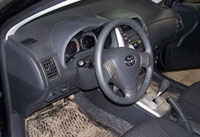 Firstly, Corolla 2007 has not at all become deep restyling of the previous body. Despite the fact that the changes in the design are not global, the new Corolla is a really new machine that is very serious from the previous one in both comfort, and in dynamics and controllability.
Firstly, Corolla 2007 has not at all become deep restyling of the previous body. Despite the fact that the changes in the design are not global, the new Corolla is a really new machine that is very serious from the previous one in both comfort, and in dynamics and controllability. Secondly, we were personally convinced that the modified multi-modal transmission is no longer a reason to refuse to purchase a machine. We are not inclined to idealize the Toyota multi-model, but, compared to MMT Yaris and Corolla Versa, this is really a huge step forward.
It looks like the only serious problem that is waiting for the owners of the new generation of Corolla is the potential tremendous popularity among hijackers. Seeing the car live, we realized that it would be much more likely to steal it than Corolla 2003.
Source: Auto.mail.ru

